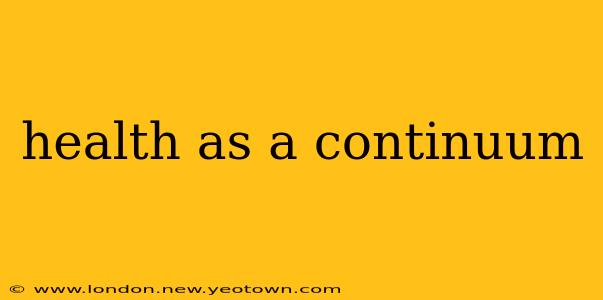We often think of health as a binary: healthy or unhealthy. But the reality is far richer and more nuanced. Health isn't a fixed point; it's a dynamic continuum, a journey constantly unfolding throughout our lives. Imagine a spectrum, not a simple on/off switch. On one end, we have optimal wellness, vibrant energy, and robust physical and mental strength. On the other, we find significant illness or disability. The space between is where most of us reside, navigating the ebb and flow of our well-being.
This understanding of health as a continuum is crucial. It shifts our perspective from a fear-based, disease-focused model to one that emphasizes proactive well-being and resilience. This journey is personal, unique, and influenced by a myriad of interconnected factors.
What Factors Influence My Position on the Health Continuum?
This is a multifaceted question, and the answer varies from person to person. However, several key factors consistently emerge:
1. Genetics: Our inherited predispositions play a significant role. Some individuals may be genetically predisposed to certain illnesses, placing them further down the continuum than others. However, it's crucial to remember that genes are not destiny.
2. Lifestyle Choices: This is where we have the most control. Our diet, exercise habits, sleep patterns, stress management techniques, and substance use profoundly impact our position on the continuum. Regular exercise, a balanced diet, sufficient sleep, and effective stress management strategies significantly contribute to optimal health.
3. Environmental Factors: Our surroundings also play a vital role. Exposure to pollution, toxins, and social determinants of health (like access to healthcare and socioeconomic status) can either support or hinder our journey toward wellness.
4. Access to Healthcare: Regular check-ups, preventive screenings, and prompt treatment of illnesses are instrumental in maintaining a healthy position on the continuum. Early intervention can often prevent minor issues from escalating into major health problems.
5. Mental and Emotional Well-being: Our mental and emotional health is inextricably linked to our physical health. Chronic stress, anxiety, and depression can significantly impact our overall well-being, potentially shifting our position on the continuum towards the unhealthy end.
How Can I Move Towards Optimal Wellness on the Health Continuum?
The good news is that we have considerable agency in shaping our health journey. Small, consistent changes can make a big difference over time.
1. Prioritize Preventative Care: Regular checkups, screenings, and vaccinations are crucial in preventing and early detection of illnesses.
2. Adopt a Healthy Lifestyle: Incorporate regular physical activity, a balanced diet rich in fruits, vegetables, and whole grains, and prioritize sufficient sleep.
3. Manage Stress Effectively: Practice stress-reduction techniques such as meditation, yoga, or spending time in nature.
4. Cultivate Strong Social Connections: Nurturing relationships with family and friends provides emotional support and reduces feelings of isolation.
5. Seek Professional Help When Needed: Don't hesitate to reach out to healthcare providers or mental health professionals if you're struggling with your health.
Is Health a Static Condition or a Dynamic Process?
Health is undeniably a dynamic process. It's not a destination we reach and then maintain; rather, it's a continuous journey requiring ongoing effort and attention. Our position on the health continuum is constantly shifting in response to various factors. Understanding this dynamic nature allows us to approach health with a more holistic and proactive mindset.
What are the Stages or Levels in the Health Continuum?
There isn't a universally agreed-upon set of stages or levels. However, we can visualize the continuum with different levels of well-being, ranging from optimal wellness at one end to severe illness at the other. Each individual’s experience along this continuum will be unique.
How Does the Health Continuum Model Differ from the Traditional Medical Model?
The traditional medical model often focuses on treating illness after it develops. The health continuum model emphasizes prevention and proactive well-being, viewing health as a dynamic process rather than a static state.
Understanding health as a continuum empowers us to take a more proactive role in managing our well-being. It's a journey of continuous improvement, with setbacks and triumphs along the way. By focusing on lifestyle choices, preventative care, and mental wellness, we can move steadily towards a healthier, more fulfilling life.

